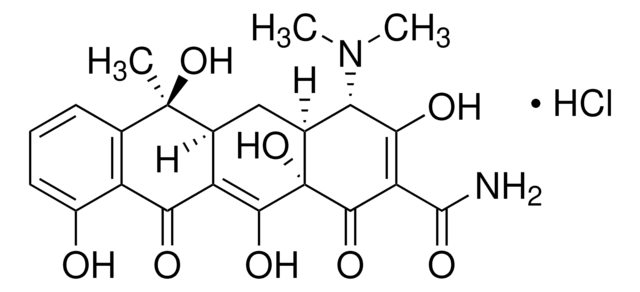BP480
Tetracycline hydrochloride
British Pharmacopoeia (BP) Reference Standard
About This Item
Recommended Products
grade
pharmaceutical primary standard
API family
tetracycline
form
crystalline powder
shelf life
limited shelf life, expiry date on the label
manufacturer/tradename
BP
mp
220-223 °C (lit.)
application(s)
pharmaceutical
pharmaceutical small molecule
format
neat
storage temp.
−20°C
SMILES string
Cl.CN(C)[C@H]1[C@@H]2C[C@H]3C(=C(O)[C@]2(O)C(=O)C(C(N)=O)=C1O)C(=O)c4c(O)cccc4[C@@]3(C)O
InChI
1S/C22H24N2O8.ClH/c1-21(31)8-5-4-6-11(25)12(8)16(26)13-9(21)7-10-15(24(2)3)17(27)14(20(23)30)19(29)22(10,32)18(13)28;/h4-6,9-10,15,25,27-28,31-32H,7H2,1-3H3,(H2,23,30);1H/t9-,10-,15-,21+,22-;/m0./s1
InChI key
XMEVHPAGJVLHIG-FMZCEJRJSA-N
Looking for similar products? Visit Product Comparison Guide
General description
Application
Also used in monographs such as:
Biochem/physiol Actions
Mode of Resistance: The effects are inactivated via a loss of cell wall permeability.
Antimicrobial spectrum: Includes a wide range of antimicrobial activity against gram-positive and gram-negative bacteria.
Packaging
Other Notes
Related product
signalword
Warning
Hazard Classifications
Aquatic Acute 1 - Aquatic Chronic 2 - Eye Irrit. 2 - Repr. 2 - Skin Irrit. 2 - STOT SE 3
target_organs
Respiratory system
Storage Class
11 - Combustible Solids
wgk_germany
WGK 2
flash_point_f
Not applicable
flash_point_c
Not applicable
Choose from one of the most recent versions:
Certificates of Analysis (COA)
Sorry, we don't have COAs for this product available online at this time.
If you need assistance, please contact Customer Support.
Already Own This Product?
Find documentation for the products that you have recently purchased in the Document Library.
Our team of scientists has experience in all areas of research including Life Science, Material Science, Chemical Synthesis, Chromatography, Analytical and many others.
Contact Technical Service



